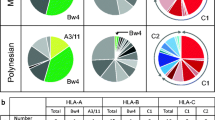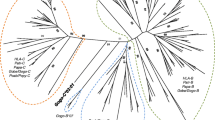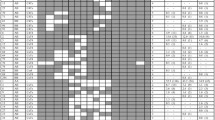Abstract
The frequencies of alleles of killer cell immunoglobulin-like receptor genes, KIR3DL3 and KIR3DL2, and the carrier frequency of KIR2DL4 alleles have been determined from a population of African Americans (n = 100) by DNA sequencing of the coding regions. Fifty alleles of KIR3DL3 were observed with the most frequent, KIR3DL3*00901 (13%). KIR3DL2 was also diverse; 32 alleles with KIR3DL2*00103 the most frequent (17%). For KIR2DL4, of the 18 alleles observed, one allele, KIR2DL4*00103, was found in 64 of the 100 individuals. Thirty-six novel alleles encoding a total of 28 unique receptors are described. Pairwise comparisons among all of the alleles at each locus suggest a predominance of synonymous substitutions. The variation at all three framework loci fits a neutral model of evolution.

Similar content being viewed by others
References
Artavanis-Tsakonas K, Eleme K, McQueen KL, Cheng NW, Parham P, Davis DM, Riley EM (2003) Activation of a subset of human NK cells upon contact with Plasmodium falciparum-infected erythrocytes. J Immunol 171:5396–5405
Bryceson YT, Long EO (2008) Line of attack: NK cell specificity and integration of signals. Curr Opin Immunol 20:344–352
Ewens W (1972) The sampling theory of selectively neutral alleles. Theor Pop Biol 3:87–112
Faure M, Long EO (2002) KIR2DL4 (CD158d), an NK cell-activating receptor with inhibitory potential. J Immunol 168:6208–6214
Gardiner CM, Guethlein LA, Shilling HG, Pando M, Carr WH, Rajalingam R, Vilches C, Parham P (2001) Different NK cell surface phenotypes defined by the DX9 antibody are due to KIR3DL1 gene polymorphism. J Immunol 166:2992–3001
Garrigan D, Hedrick PW (2003) Perspective: detecting adaptive molecular polymorphism: lessons from the MHC. Evolution 57:1707–1722
Gedil MA, Steiner NK, Hurley CK (2005) Genomic characterization of KIR2DL4 in families and unrelated individuals reveals extensive diversity in exon and intron sequences including a common frameshift variation occurring in several alleles. Tissue Antigens 65:402–418
Gedil MA, Steiner NK, Hurley CK (2007) KIR3DL2: diversity in a hematopoietic stem cell transplant population. Tissue Antigens 70:228–232
Goodridge JP, Lathbury LJ, Steiner NK, Shulse CN, Pullikotil P, Seidah NG, Hurley CK, Christiansen FT, Witt CS (2007) Three common alleles of KIR2DL4 (CD158d) encode constitutively expressed, inducible and secreted receptors in NK cells. Eur J Immunol 37:199–211
Guo SW, Thompson EA (1992) Performing the exact test of Hardy–Weinberg proportion for multiple alleles. Biometrics 48:361–372
Hansasuta P, Dong T, Thananchai H, Weekes M, Willberg C, Aldemir H, Rowland-Jones S, Braud VM (2004) Recognition of HLA-A3 and HLA-A11 by KIR3DL2 is peptide-specific. Eur J Immunol 34:1673–1679
Hou L, Chen M, Steiner NK, Belle I, Turino C, Ng J, Hurley CK (2007) Seventeen novel alleles add to the already extensive KIR3DL3 diversity. Tissue Antigens 70:449–454
Hou L, Chen M, Jiang B, Kariyawasam K, Ng J, Hurley CK (2009) In contrast to other stimulatory natural killer cell immunoglobulin-like receptor loci, several KIR2DS5 alleles predominate in African Americans. Hum Immunol 70:733–737
Hou L, Chen M, Jiang B, Ng J, Hurley CK (2010) African Americans exhibit a predominant allele in the midst of extensive KIR2DL1 allelic diversity. Tissue Antigens 76:31–34
Jiang B, Hou L, Chen M, Ng J, Hurley CK (2010) The profile of KIR3DL1 and KIR3DS1 alleles in an African American population resembles that found in African populations. Tissue Antigens 76:64–66
Jones DC, Hiby SE, Moffett A, Trowsdale J, Young NT (2006) Nature of allelic sequence polymorphism at the KIR3DL3 locus. Immunogenetics 58:614–627
Jonsson AH, Yokoyama WM (2009) Natural killer cell tolerance licensing and other mechanisms. Adv Immunol 101:27–79
Kelley J, Walter L, Trowsdale J (2005) Comparative genomics of natural killer cell receptor gene clusters. PLoS Genet 1:129–139
Kikuchi-Maki A, Yusa S, Catina TL, Campbell KS (2003) KIR2DL4 is an IL-2-regulated NK cell receptor that exhibits limited expression in humans but triggers strong IFN-gamma production. J Immunol 171:3415–3425
Kollnberger S, Chan A, Sun MY, Chen LY, Wright C, di Gleria K, McMichael A, Bowness P (2007) Interaction of HLA-B27 homodimers with KIR3DL1 and KIR3DL2, unlike HLA-B27 heterotrimers, is independent of the sequence of bound peptide. Eur J Immunol 37:1313–1322
Korber B (2000) In: Rodrigo AG, Learn GH (eds) HIV signature and sequence variation analysis. Kluwer, Dordrecht, pp 55–72
Kryazhimskiy S, Plotkin JB (2008) The population genetics of dN/dS. PLoS Genet 4:e1000304
Lancaster AK, Nelson MP, Single RM, Meyer D, Thomson G (2003) In: Altman RB, Dunker K, Hunter L, Jung T, Klein T (eds) PyPop: a software framework for population genomics: analyzing large-scale multi-locus genotype data. World Scientific, Singapore, pp 514–525
Lancaster AK, Single RM, Solberg OD, Nelson MP, Thomson G (2007) PyPop update—a software pipeline for large-scale multilocus population genomics. Tissue Antigens 69:192–197
Lanier LL (2005) NK cell recognition. Annu Rev Immunol 23:225–274
Librado P, Rozas J (2009) DnaSP v5: a software for comprehensive analysis of DNA polymorphism data. Bioinformatics 25:1451–1452
Maiers M, Gragert L, Klitz W (2007) High-resolution HLA alleles and haplotypes in the United States population. Hum Immunol 68:779–788
Marsh SGE, Parham P, Dupont B, Geraghty DE, Trowsdale J, Middleton D, Vilches C, Carrington M, Witt C, Guethlein LA, Shilling H, Garcia CA, Hsu KC, Wain H (2003) Killer-cell immunoglobulin-like receptor (KIR) nomenclature report, 2002. Tissue Antigens 62:79–86
Martin AM, Freitas EM, Witt CS, Christiansen FT (2000) The genomic organization and evolution of the natural killer immunoglobulin-like receptor (KIR) gene cluster. Immunogenetics 51:268–280
Martin MP, Bashirova A, Traherne J, Trowsdale J, Carrington M (2003) Cutting edge: expansion of the KIR locus by unequal crossing over. J Immunol 171:2192–2195
Meyer D, Single R, Mack SJ, Lancaster A, Nelson MP, Erlich HA, Fernandez-Vina M, Thomson G (2006) In: Hansen JA (ed) 13th IHWS anthropology/human genetic diversity joint report. Chapter 4. Single locus polymorphism of classical HLA genes. International Histocompatibility Working Group Press, Seattle, pp 653–704
Nei M, Gojobori T (1986) Simple methods for estimating the numbers of synonymous and nonsynonymous nucleotide substitutions. Mol Biol Evol 3:418–426
Nei M, Suzuki Y, Nozawa M (2010) The neutral theory of molecular evolution in the genomic era. Annu Rev Genomics Hum Genet 11:265–289
Norman PJ, Carrington CVF, Byng M, Maxwell LD, Curran MD, Stephens HAF, Chandanayingyong D, Verity DH, Hameed K, Ramdath DD, Vaughan RW (2002) Natural killer cell immunoglobulin-like receptor (KIR) locus profiles in African and South Asian populations. Genes Immun 3:86–95
Norman PJ, Abi-Rached L, Gendzekhadze K, Hammond JA, Moesta AK, Sharma D, Graef T, McQueen KL, Guethlein LA, Carrington CV, Chandanayingyong D, Chang YH, Crespi C, Saruhan-Direskeneli G, Hameed K, Kamkamidze G, Koram KA, Layrisse Z, Matamoros N, Mila J, Park MH, Pitchappan RM, Ramdath DD, Shiau MY, Stephens HA, Struik S, Tyan D, Verity DH, Vaughan RW, Davis RW, Fraser PA, Riley EM, Ronaghi M, Parham P (2009) Meiotic recombination generates rich diversity in NK cell receptor genes, alleles, and haplotypes. Genome Res 19:757–769
Ordonez D, Meenagh A, Gomez-Lozano N, Castano J, Middleton D, Vilches C (2008) Duplication, mutation and recombination of the human orphan gene KIR2DS3 contribute to the diversity of KIR haplotypes. Genes Immun 9:431–437
Ponte M, Cantoni C, Biassoni R, Tradori-Cappai A, Bentivoglio G, Vitale C, Bertone S, Moretta A, Moretta L, Mingari MC (1999) Inhibitory receptors sensing HLA-G1 molecules in pregnancy: decidua-associated natural killer cells express LIR-1 and CD94/NKG2A and acquire p49, an HLA-G1-specific receptor. Proc Natl Acad Sci U S A 96:5674–5679
Pyo CW, Guethlein LA, Vu Q, Wang R, Abi-Rached L, Norman PJ, Marsh SG, Miller JS, Parham P, Geraghty DE (2010) Different patterns of evolution in the centromeric and telomeric regions of group A and B haplotypes of the human killer cell Ig-like receptor locus. PLoS ONE 5:e15115
Rajagopalan S, Fu J, Long EO (2001) Cutting edge: induction of IFN-gamma production but not cytotoxicity by the killer cell Ig-like receptor KIR2DL4 (CD158d) in resting NK cells. J Immunol 167:1877–1881
Rajagopalan S, Bryceson YT, Kuppusamy SP, Geraghty DE, van der Meer A, Joosten I, Long EO (2006) Activation of NK cells by an endocytosed receptor for soluble HLA-G. PLoS Biol 4:e9
Rajalingam R, Parham P, Abi-Rached L (2004) Domain shuffling has been the main mechanism forming new hominoid killer cell Ig-like receptors. J Immunol 172:356–369
Rogers AR, Harpending H (1992) Population growth makes waves in the distribution of pairwise genetic differences. Mol Biol Evol 9:552–569
Saitou N, Nei M (1987) The neighbor-joining method: a new method for reconstructing phylogenetic trees. Mol Biol Evol 4:406–425
Salamon H, Klitz W, Easteal S, Gao X, Erlich HA, Fernandez-Vina M, Trachtenberg EA, McWeeney SK, Nelson MP, Thomson G (1999) Evolution of HLA class II molecules: allelic and amino acid site variability across populations. Genetics 152:393–400
Shulse C, Steiner NK, Hurley CK (2007) Allelic diversity in KIR2DL4 in a bone marrow transplant population: description of three novel alleles. Tissue Antigens 70:157–159
Sivori S, Falco M, Carlomagno S, Romeo E, Soldani C, Bensussan A, Viola A, Moretta L, Moretta A (2010) A novel KIR-associated function: evidence that CpG DNA uptake and shuttling to early endosomes is mediated by KIR3DL2. Blood 116:1637–1647
Slatkin M (1994) An exact test for neutrality based on the Ewens sampling distribution. Genet Res 64:71–74
Slatkin M (1996) A correction to the exact test based on the Ewens sampling distribution. Genet Res 68:259–260
Slatkin M, Hudson RR (1991) Pairwise comparisons of mitochondrial DNA sequences in stable and exponentially growing populations. Genetics 129:555–562
Tajima F (1989) Statistical method for testing the neutral mutation hypothesis by DNA polymorphism. Genetics 123:585–595
Tamura K, Dudley J, Nei M, Kumar S (2007) MEGA4: Molecular Evolutionary Genetics Analysis (MEGA) software version 4.0. Mol Biol Evol 24:1596–1599
Tishkoff SA, Reed FA, Friedlaender FR, Ehret C, Ranciaro A, Froment A, Hirbo JB, Awomoyi AA, Bodo JM, Doumbo O, Ibrahim M, Juma AT, Kotze MJ, Lema G, Moore JH, Mortensen H, Nyambo TB, Omar SA, Powell K, Pretorius GS, Smith MW, Thera MA, Wambebe C, Weber JL, Williams SM (2009) The genetic structure and history of Africans and African Americans. Science 324:1035–1044
Traherne JA, Martin M, Ward R, Ohashi M, Pellett F, Gladman D, Middleton D, Carrington M, Trowsdale J (2010) Mechanisms of copy number variation and hybrid gene formation in the KIR immune gene complex. Hum Mol Genet 19:737–751
Trundley AE, Hiby SE, Chang C, Sharkey AM, Santourlidis S, Uhrberg M, Trowsdale J, Moffett A (2006) Molecular characterization of KIR3DL3. Immunogenetics 57:904–916
Wilson MJ, Torkar M, Haude A, Milne S, Jones T, Sheer D, Beck S, Trowsdale J (2000) Plasticity in the organization and sequences of human KIR/ILT gene families. Proc Natl Acad Sci U S A 97:4778–4783
Yawata M, Yawata N, Draghi M, Little AM, Partheniou F, Parham P (2006) Roles for HLA and KIR polymorphisms in natural killer cell repertoire selection and modulation of effector function. J Exp Med 203:633–645
Zhu FM, Jiang K, Lv QF, He J, Yan LX (2006) Investigation of killer cell immunoglobulin-like receptor KIR2DL4 diversity by sequence-based typing in Chinese population. Tissue Antigens 67:214–221
Acknowledgments
This research is supported by funding from the Office of Naval Research N00014-08-1-1078. The views expressed in this article are those of the authors and do not reflect the official policy or position of the Department of the Navy, the Department of Defense, or the US government. The authors would like to thank Drs. Steven Mack and Matthew Hamilton for helpful discussions.
Author information
Authors and Affiliations
Corresponding author
Rights and permissions
About this article
Cite this article
Hou, L., Jiang, B., Chen, M. et al. The characteristics of allelic polymorphism in killer-immunoglobulin-like receptor framework genes in African Americans. Immunogenetics 63, 549–559 (2011). https://doi.org/10.1007/s00251-011-0536-6
Received:
Accepted:
Published:
Issue Date:
DOI: https://doi.org/10.1007/s00251-011-0536-6




